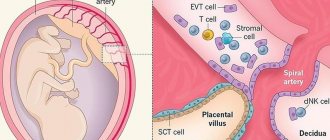No pregnant woman is immune from various complications. She can learn about them at different times in her “interesting” position. One of these diagnoses that darkens the mood of the expectant mother may be low placentation. What is it, is it possible to recognize this condition before an ultrasound scan, what to do to maintain pregnancy and how the birth will proceed - we will give answers to these questions.
What is low placentation?
The placenta is an organ necessary for the development and successful gestation of the fetus. It is formed in the uterus. Through the circulatory system of the placenta, the embryo receives nutrients and oxygen. When is the placenta formed? The initial stage of this process begins closer to the seventh day after conception. During this period, the placenta precursor, the outer membrane, develops around the fetus. The process of its formation is completed by the 20th week of pregnancy. The course of pregnancy and childbirth depends on the placenta’s attachment to the wall of the uterus. Ideally, the placenta is attached at the highest point inside the uterus: there are better conditions for the development of the embryo and excellent blood flow. But often a pregnant woman is diagnosed with a low-lying placenta. This is low placentation. In this condition, the embryo is attached closer to the exit of the uterus (throat) closer than 5.5-6 cm.
Publications in the media
Placenta previa is an anomaly of the location of the placenta, characterized by the attachment of the placenta in the lower pole of the uterus and partial or complete obstruction of the internal os or very close location to it. Statistical data. Frequency : 1 case per 200 full-term pregnancies. In Russia, the frequency of placenta previa in relation to the total number of births is 0.2–0.8%. The increase in the incidence of placenta previa over the past 10–15 years appears to be due to an increase in the number of abortions and intrauterine interventions.
Classification • Complete placenta previa - the placenta completely covers the internal os • Lateral placenta previa - the placenta covers 2/3 of the internal os • Marginal placenta previa - the placenta covers 1/3 of the internal os; the edge of the placenta can be palpated at the edge of the internal os • Low location of the placenta - the placenta is located in the lower segment of the uterus, but its lower edge does not reach the internal os by 2 cm; during a vaginal examination, only the membranes can be palpated through the cervix with a finger. Etiology • Maternal factors •• A large number of births in the anamnesis •• Age - in pregnant women over 35 years of age, regardless of the number of births in the anamnesis, placenta previa is observed more often • Factors caused by the pathology of the placenta. In most cases, placenta previa is a consequence of improper implantation of the conceptus •• Impaired vascularization of the decidua, caused by atrophic changes or an inflammatory process; in this case, the chorionic villi are attached in the place most favorable for implantation. “Migration of the placenta” - search by chorionic villi for the most favorable conditions for implantation •• Changes in the endometrium associated with repeated pregnancies •• Vascular changes at the site of placenta attachment. When the blood supply to the endometrium deteriorates, a larger surface area for the placenta is required •• An increase in the surface of the placenta during multiple pregnancies leads to the fact that the lower edge of the placenta reaches the area of the internal os •• Fetal erythroblastosis •• Impaired blood supply to the endometrium and changes in the endometrium due to previous surgical interventions in the lower segment of the uterus ( e.g. myomectomy, caesarean section, hysterotomy). Pathogenesis • Bleeding is caused by detachment of the part of the placenta that overlaps the internal os or located near it • The placental tissue is not able to stretch, therefore, when the underlying uterine wall is stretched, part of the placenta peels off, the intervillous spaces are opened, and heavy bleeding occurs. Bleeding continues because the stretched SMCs of the lower segment of the uterus are unable to contract and compress the vessels.
Clinical picture • Bleeding from the vagina, not accompanied by pain, intensifying or renewing with the onset of labor •• Bleeding can occur unexpectedly and without any warning or with stress, as well as after injury, sexual intercourse or vaginal examination •• Bleeding for the first time usually occurs at the beginning III trimester of pregnancy as a result of uterine contractions or during cervical dilatation. • When placental abruption occurs, the pregnant woman loses blood, the condition of the fetus worsens •• Vaginal examination may increase bleeding. Shock may occur with acute blood loss •• Fetal distress may result from shock in the pregnant woman. Diagnostics. Placenta previa should be suspected when bleeding from the vagina is not accompanied by pain and occurs in the third trimester of pregnancy. The high standing of the presenting part of the fetus with a normal pregnant pelvis also indicates placenta previa. If placenta previa is suspected, the vagina should be examined with a speculum to exclude other causes of bleeding; the study is carried out in a hospital with a full operating room • Indirect diagnosis •• Ultrasound - the sensitivity of the method is 90–95% •• Isotope scanning, amniography and arteriography are invasive diagnostic methods that pose a potential risk to the woman and fetus due to irradiation, amniocentesis and arterial puncture • Final The diagnosis of placenta previa is established by palpation of the placenta or its edge after passing through the cervical canal. Vaginal examination can lead to increased bleeding, so it is performed only in extreme cases and in full operating room.
Laboratory tests • Blood type, Rh affiliation (not only to determine the presence and degree of Rh sensitization, but also in case of acute blood loss and the need for blood transfusion) •• If a woman’s blood is Rh negative, a positive Kleihauer-Betke test allows us to calculate the amount of Rh -positive erythrocytes that entered the bloodstream during bleeding from the fetus to the mother •• Positive test for AT, if isosensitization of Ag Rh0-D has occurred • Complete clinical blood test with platelet count, determination of coagulability •• Normocytic normochromic anemia against the background of acute bleeding •• PT, PTT, fibrinogen content. The fibrinogen content increases to 3.5–5.5 g/l in the third trimester and should decrease to 1–1.5 g/l before the PTT begins to increase •• If there is a suspicion of the development of disseminated intravascular coagulation, it must be remembered that the content of fibrin breakdown products during pregnancy it increases and therefore is not so informative for diagnosis •• Increased PT and PTT, fibrinogen content less than 1.0–1.5 g/l; with the development of DIC, the number of platelets decreases sharply • Test for the compatibility of the woman’s blood with the donor’s blood (carried out three times) if a blood transfusion is necessary. Special research methods • Kleihauer-Betke test to detect the penetration of blood from the fetus to the mother • Coagulation test at the bedside of a pregnant woman: absence or weak blood clotting after 7-10 minutes indicates coagulopathy • An informative test to determine the fetal origin of blood: mix blood taken from the woman’s vagina, with a small amount of tap water (so that hemolysis occurs), is centrifuged for several minutes; the pink supernatant is then mixed with sodium hydroxide (1 ml NaOH for every 5 ml liquid); if the fluid contains fetal Hb, after 2 minutes its color will remain pink, adult Hb will give a yellow-brown color • Hematological staining of vaginal blood and identification of red blood cells containing nuclei (usually of fetal origin) • Determination of the lecithin/sphingomyelin (L/S) ratio in amniotic fluid, if the issue of premature birth is being decided. Differential diagnosis • Cervical pregnancy • Premature abruption of a normally located placenta • Uterine rupture • Blood diseases • Rupture of vaginal varicose veins • Cervical erosion • Polyps and cervical cancer.
TREATMENT Management tactics. Immediate hospitalization is required. 3 factors should be taken into account • New bleeding is often very heavy • Vaginal and rectal examinations often lead to severe bleeding • The main cause of perinatal mortality is prematurity, acute hypoxia. Conservative management is warranted if the fetus is premature. Expectant management is permissible only in the absence of labor, stable condition of the fetus and minor bleeding • Hospitalization • Careful speculum examination to exclude local damage to the cervix and vagina • Careful assessment of the condition of the fetus to exclude placental abruption • Determination of the location of the placenta and the type of its presentation. Drug therapy • Infusion therapy: • • Ethylated starches • • Ringer's solution, 0.9% sodium chloride solution • Oxygen • Fresh frozen plasma and platelet mass • Cryoprecipitate and fibrinogen are used when the above measures are ineffective • Tocolytics (prescribed with caution; contraindicated in case of severe bleeding) •• The drug of choice is magnesium sulfate; first, a loading dose of 4 g is administered intravenously, and then, according to indications, 1–4 g/h •• Contraindications to the use of tocolytics: full-term pregnancy, unstable condition of the pregnant woman, impaired renal function •• Side effects of magnesium sulfate - nausea, headache pain, hot flashes. Delivery . In case of complete (central) placenta previa, delivery is carried out only by cesarean section (absolute indication). Surgical delivery is also carried out in case of partial placenta previa, if the bleeding is intense and the birth canal is not prepared for childbirth. • Amniotomy is indicated when the woman’s condition is satisfactory and there is minor bleeding. After part of the amniotic fluid has drained, the fetal head descends and presses against the bleeding area. Often the bleeding stops. During vaginal delivery, manual examination of the uterine cavity and prevention of uterine hypotonic bleeding are indicated.
• Planned cesarean section is carried out when the fetal body weight is more than 2500 g, the gestational age is at least 36–37 weeks (according to ultrasound) and the maturity of the fetal lungs (according to the study of amniotic fluid, the L/C ratio is 2 or more; phosphatidylglycerol is present). • Emergency caesarean section is performed if bleeding poses a threat to the woman's life, regardless of the body weight and gestational age of the fetus. • Application of skin-head forceps according to Wilt-Ivanov is carried out if it is impossible to perform a cesarean section and in case of death or non-viability of the fetus. Using specially designed forceps, grasp the fold of skin on the fetal head, and hang a weight (200–300 g) from the handle. The descending head presses the placenta to the lower segment of the uterus, bleeding stops. • Reduction of the leg in a mixed breech presentation is also performed if it is impossible to perform a cesarean section and in the event of death or non-viability of the fetus. Complications • Pituitary necrosis (Scheen's syndrome) or kidney damage (acute renal tubular necrosis) may result from massive blood loss and prolonged hypotension • Severe postpartum hemorrhage. Since the placenta is located in the lower segment of the uterus (the muscular layer is poorly expressed), contractions of the myometrium do not stop bleeding • Placenta accreta (ingrowth of placental tissue into the myometrium). Prevention of recurrent bleeding • Reduce physical activity • Vaginal examination, sexual intercourse, douching and other impacts on the vagina should be avoided. Reduction. L/S - lecithin/sphingomyelin.
ICD-10 • O44 Placenta previa
Causes of low placental attachment
Why is the placenta low? There are many reasons. Conventionally, they are divided into congenital and acquired - due to previous illnesses, operations, abortions. Reasons for low placental attachment include:
- anomaly in the development of the internal genital organs of a woman;
- age over 30 years;
- inflammatory diseases of the uterine mucosa and pelvic organs;
- presence of sexually transmitted diseases;
- previous surgeries on the reproductive organs;
- neoplasms in the uterus;
- multiple pregnancy;
- a large number of births;
- childbirth with bleeding and separation of the placenta;
- artificial termination of pregnancy (abortion)
Recommendations for women with low placenta
Despite high-tech advances in the field of medicine, today there is still no drug therapy for a global solution to the problem of low placenta. However, some medications are prescribed to reduce the risks associated with this condition. For example, a low location of the placenta during pregnancy may be accompanied by bleeding, which can be either small or heavy. To minimize this risk, doctors may prescribe antispasmodic medications. Vitamins B and E, iron supplements and folic acid may also be prescribed as therapeutic agents to improve the woman's general condition.
You should not ignore a low location of the placenta determined by your doctor, since this condition increases the likelihood of spontaneous miscarriage or premature birth. Pregnant women with this diagnosis are contraindicated in physical activity and any stressful situations. During the entire period of bearing a child, the expectant mother should not only play sports, but even drive on uneven roads, since any shaking can provoke bleeding. Having sex with a low placenta is also not recommended, since contractions of the uterine muscles can lead to bleeding.
The danger of low placentation for pregnancy
If the placenta is descended, the fetus puts pressure on it as it grows. This can lead to bleeding and placental abruption. The latter is a serious threat not only to the life of the unborn baby, but also to the life of the pregnant woman.
Another thing low placentation threatens is the threat of miscarriage and other complications. As the fetus grows, the placenta moves. With low placentation along the anterior wall, it is possible that the umbilical cord may become entangled and the exit from the uterus may be blocked.
If a pregnant woman has low placentation along the posterior wall, there may be more complications. Subjectively, a woman may feel pressure in the lower abdomen and complain of pain, which will intensify as the fetus grows. Since there are few blood vessels in the lower part of the uterus, due to a prolapsed placenta, the fetus may not receive enough oxygen and nutrients.
Symptoms of low placenta previa during pregnancy
This pathology does not have any specific external signs. Low placentarity is manifested by the following symptoms:
- Bleeding. Already at 12-13 weeks, women with this anomaly may begin to experience uterine discharge mixed with blood, which is associated with microdetachments of the “baby spot” from the endometrium. Most often, this symptom manifests itself in the last trimester of pregnancy, when the fetus grows to a large size and, with movements, more strongly tears the placenta from the uterus. In the later stages, even a slight stress (coughing, orgasm, sneezing, constipation, etc.) can lead to heavy bleeding, threatening the life of the mother and her child. Due to periodic or constant blood loss, women often experience symptoms of anemia - dizziness, weakness, low blood pressure and hemoglobin levels in the blood.
- High position of the uterine fundus. Based on the location of the upper part of the uterus, the doctor usually judges the degree of development of pregnancy. With placental presentation, the uterine fundus is often located too high, which may indirectly indicate a low location of the placenta.
- Fetal presentation. The location of the baby, uterus and placenta are interdependent. Therefore, pelvic or transverse presentation of the fetus is often accompanied by a low localization of the “baby spot,” which the doctor can judge from the data obtained during an ultrasound examination of the patient.
Often this pathology (especially in the early stages) is completely asymptomatic. The woman may not feel pain or discomfort in the lower abdomen, and she does not have periodic or constant bleeding. Therefore, it is possible to unambiguously identify low placenta previa only with the help of modern diagnostic tools during routine gynecological examinations. Ultrasound is most effective in this regard. This method has the following advantages:
- Minimally invasive. If low placenta previa is suspected, an ultrasound examination is performed abdominally. The scanner is located on the outer surface of the abdomen; the doctor does not make any incisions, so ultrasound does not create any risks for the child or mother.
- Information content. Modern ultrasound machines have high resolution and accurately visualize the position of the baby in the uterus. With their help, the doctor can determine the location of the placenta, the distance from its edge to the uterine os.
If low placental capacity is suspected, your doctor may order an unscheduled scan to monitor placental migration. The procedure is usually performed at 12, 20 and 30 weeks of pregnancy, but more frequent ultrasounds are also possible.
A gynecological examination, which is standard during normal pregnancy, is not performed with this pathology. This is due to the fact that inserting instruments into the vagina can cause strong contractions of the uterus, which will result in premature labor with extensive bleeding.
Take the first step
make an appointment with a doctor!
Central (complete) placenta previa
This is a more serious diagnosis than low placentation in pregnant women.
With central presentation, the placenta is located at the bottom of the uterus, blocking the exit from it. There is also partial presentation - marginal and lateral. In the first case, the placental tissue covers two-thirds of the exit from the uterus, in the second - no more than a third of its pharynx. In case of central placenta previa, delivery is carried out by caesarean section.
Placenta migration
Migration in most cases corrects improper attachment of the fetus.
Migration is a process that in most cases corrects pathology such as low placentation. It is important to understand that the placenta itself does not actually move. The change in its location is the result of the growth of the myometrium - the muscular layer of the uterus. Simply put, the placenta migrates as the uterus grows. Migration of the placenta always occurs in only one direction - from bottom to top, from the internal os of the uterus to its bottom.
It is thanks to this phenomenon that doctors do not focus on the location of the placenta until the third trimester - it has been proven that in 95% of cases the placenta rises on its own, taking the correct position.
Treatment for low placenta
There is no treatment for this condition. There are only guidelines to follow. In any case, it is better to take care of yourself and your unborn baby. With low placentation you need:
- exclude serious physical activity;
- get enough sleep and plenty of rest;
- eat right so that the child receives the right amount of vitamins;
- consult a doctor if something bothers you;
- stay calm;
- when sleeping, place a pillow under your feet - they should be above the level of the pelvis;
- temporarily give up intimate life;
- go to the hospital if the placenta has not risen by 36 weeks.
Rules of conduct and treatment
When you hear a diagnosis of “low placentation” from your attending physician, you should not panic. Firstly, panic is prohibited in any trimester of pregnancy, be it the 20th, 21st, 22nd, 23rd or 35th week. And secondly, this illness does not mean at all that the situation is dangerous and the pregnancy is doomed. This condition, depending on the distance between the placenta and the uterine os, is not always considered a pathology, but rather a borderline location of the fetus. The expectant mother will help herself if she follows some rules that the doctor will definitely tell her about:
- Avoid any physical activity, even if it is gymnastics for pregnant women. Do not make sudden movements, do not run or jump. Yes, physical activity in any trimester of pregnancy is desirable, but here we are talking more about normal gestation. It is especially dangerous to suddenly raise your arms up.
- Complete sexual rest, even if in the early stages of pregnancy sexual activity was allowed due to the absence of a threat to the child.
- Traveling in any public transport should be minimal; it is advisable to use a taxi or a personal car.
- Try to raise your legs while lying down or sitting, placing a pillow under them.
- It is imperative to call a doctor or even an ambulance at the first signs of bleeding, even before 20 weeks; a delay in this case is dangerous.
- If the treating gynecologist suggests hospitalization, you should not refuse it. Under the supervision of a doctor, maintaining a stable condition of the fetus with low placentation will be much easier.
These same tips, as a rule, are contained in any forum about pregnancy. As for the treatment of low-type placentation during pregnancy, like 20-25 weeks or any trimester, there can be no drug courses for such a diagnosis. Most often, doctors wait until the placenta itself takes the required position, which usually happens by the end of the second trimester. This is due to the constant growth of the fetus and, accordingly, the uterus, when the placenta changes its position.
Normally, it is believed that a low placenta can change its position up to 36 weeks, when the body is already preparing for childbirth. Thus, low location, regardless of whether it is diagnosed during the 20-21-22 weeks or even at 33, is not a death sentence. Treatment in this case consists only of constant medical supervision and timely scheduled examinations, including ultrasound.
Stem cells can be used to treat both the child and his relatives
Today, stem cell treatment methods are successfully used all over the world. In Ukraine, the leading position in the development and application of such techniques belongs to the Institute of Cell Therapy. Cord blood stem cells are stored in the Cryobank of the Institute of Cell Therapy in special containers under guaranteed maintenance of the necessary conditions.
Why is it worth saving cord blood in Cryobank?
Today, more than 100 diseases can be cured using stem cells. The procedure for collecting umbilical cord blood is possible only at the birth of a child - at the moment of cutting the umbilical cord.
It is absolutely safe and painless for both the child and the mother in labor. When the days are counting, and there is no way to urgently find a suitable donor, then the only way out is treatment with stem cells. While searching for a donor takes months, preparing stem cells takes several hours.
A feeling of maximum peace of mind for the most valuable thing in life - for your children - is only possible if you are 100% sure that the right medicine is at hand. It is stored in the Cryobank of the Institute of Cell Therapy and is available to you and your family upon request.
placenta









